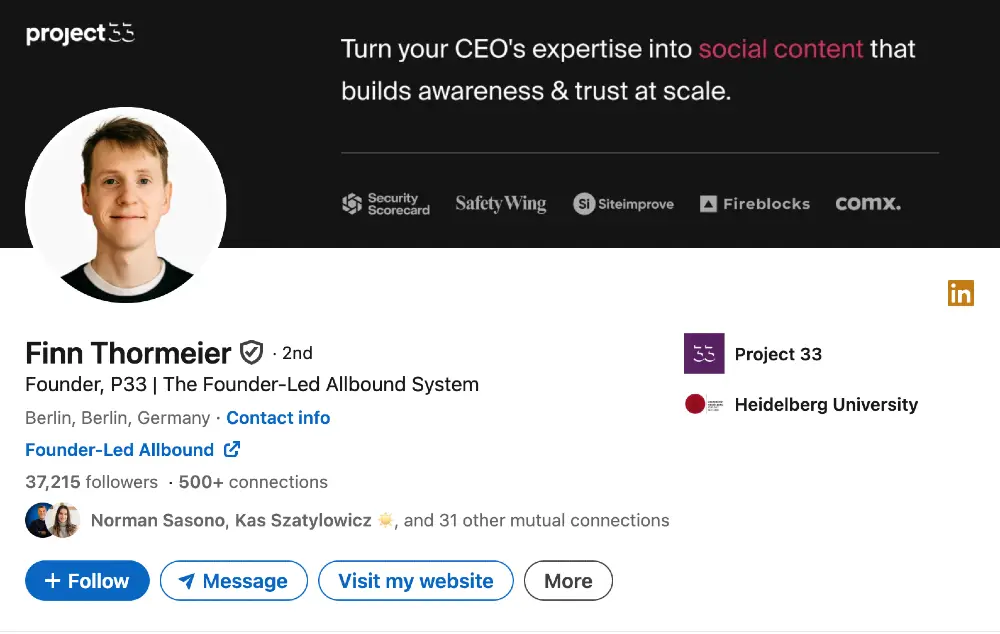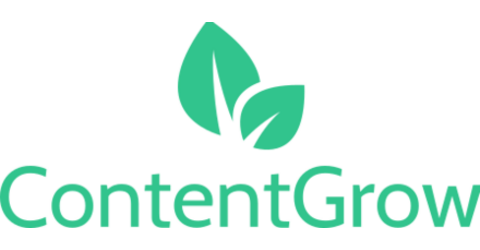Finn Thormeier's B2B outreach strategy: How to book demos with top accounts in 90 days
P33 founder Finn Thormeier shares a systematic LinkedIn strategy for booking demos with target accounts by leveraging executive visibility and content.

"Book demos with our top 100 target accounts in the next 90 days." When a CEO issues this directive, sales and marketing teams often scramble toward the usual suspects: generic cold emails with dismal 6% open rates[1], templated LinkedIn messages that go ignored, and SDR teams burning through call lists only to be blocked by gatekeepers at every turn.
Against this challenging backdrop, P33 founder Finn Thormeier has developed a systematic framework that flips the traditional outbound model on its head. Instead of relying on brute-force cold outreach, his approach leverages executive visibility, strategic content, and data-driven engagement signals to create a multi-touchpoint system that gradually warms prospects before any direct pitch occurs. The result? A methodical process for booking demos with target accounts that's both repeatable and measurable.
What is P33?
P33 is a B2B sales consultancy founded by Finn Thormeier that specializes in implementing "founder-led allbound" systems. The company helps B2B SaaS businesses develop and execute strategic outreach campaigns that leverage founders' and executives' LinkedIn profiles to connect with potential customers. P33 focuses on maximizing the impact of executive visibility in the sales process, particularly for companies targeting enterprise accounts with complex buying committees.
The challenge: Booking demos with top target accounts
The scenario Thormeier addresses is common for B2B SaaS companies: a CEO requests that the sales or marketing team book demos with 100 target accounts within 90 days. Rather than relying solely on traditional cold outreach methods, Thormeier outlines a strategic 14-step process that builds gradual connection and visibility before making any direct pitch.
His approach is particularly suited for companies selling technical products with higher price points (the example uses a $70k ACV product that improves developer velocity, targeting VPs of Engineering).
The 14-step LinkedIn outreach framework
Let's break down Thormeier's systematic approach for booking demos with target accounts:
Step 1-2: Profile optimization for company leaders

The foundation of Thormeier's approach involves gaining access to and optimizing the LinkedIn profiles of key company executives:
- Access both the CEO's and CTO's LinkedIn profiles (if selling a technical product)
- Update profile pictures to professional quality
- Modify taglines to highlight the specific problem your product solves
- Add social proof to banner images
- Include a "visit my website" button
- Properly connect company pages
- Remove the "Message" button to avoid unwanted inbound messages
This profile optimization ensures that when prospects view executive profiles, they immediately understand the company's value proposition and social proof.
Step 3-5: Strategic connection building with Sales Navigator
With optimized profiles in place, the next phase focuses on methodical connection building:
- Use Sales Navigator to identify 3-5 relevant people besides the primary target (VP of Engineering) at each account
- This might include Engineering Directors, Heads of DevOps, etc.
- Send connection requests (maximum 100 per week) from the executives' profiles without an accompanying message
- Create lead lists in Sales Navigator to monitor target accounts' activities
- Daily monitoring to identify when targets post content
- Send relevant activity links to executives in Slack so they can comment
The approach leverages Sales Navigator's social selling capabilities to strategically build a network among target accounts. By focusing on multiple stakeholders within each company, it increases the chances of connecting with decision-makers and influencers. This approach aligns with industry best practices for account-based marketing strategies.
Step 6-7: Content creation and posting strategy
With connections growing, Thormeier recommends creating pillar content to showcase executives' expertise:
- Create 10 pillar posts for both the CEO and CTO, including:
- Why they built the product
- How the product solves specific problems
- Customer case studies with results
- Why engineering teams should prioritize the solution
- Interview executives using tools like Riverside.fm to create bite-sized video and text content
- Schedule 2-3 posts per week consistently
This content strategy serves dual purposes: establishing thought leadership while providing valuable materials for the next phase of engagement.
Step 8-9: Amplifying reach with LinkedIn ads
After four weeks of consistent execution, Thormeier notes companies will typically have:
- Sent connection requests to 400 decision-makers (with approximately 50% acceptance)
- Published 20 LinkedIn posts between the CEO and CTO
- Established multiple touchpoints with ICPs through engagement
This creates the foundation for the next phase: targeted LinkedIn ad campaigns. Thormeier recommends:
- Taking the 20 posts and using them in LinkedIn Text Ad campaigns
- Creating two separate campaigns:
- One targeting the 400 identified decision-makers directly
- Another targeting broader engineering departments, product teams, and IT professionals at target companies
- Allocating approximately US$900/month in ad budget
- Aiming for a frequency of 8-12 views per target over 30 days
The dual-campaign approach addresses a common LinkedIn advertising challenge: the platform's algorithm naturally optimizes for cheaper results (often junior employees) unless specifically constrained to target more expensive decision-maker segments.
Step 10-14: Signal collection and warm outreach
The final phase involves systematically gathering engagement signals and using them to trigger personalized outreach:
- Continue daily engagement with target accounts' posts while running ads
- Collect engagement signals using tools like Trigify.io (for post engagers) and Fibbler (for ad engagement)
- Build lists of LinkedIn profile visitors in Sales Navigator
- Pull all data into a system like Clay for enrichment
- Score accounts by engagement level
- Enroll the most engaged accounts in a warm outbound campaign using Apollo
- Use a combination of LinkedIn messages, email, and phone outreach
- Continually refresh the warm outreach pipeline as more accounts show engagement signals
According to Thormeier, this systematic approach creates a continuous pipeline of increasingly qualified opportunities that have already been exposed to your content and value proposition.
Why this approach works: The psychology of multi-touch engagement
The effectiveness of Thormeier's framework stems from several psychological principles that align with how B2B buyers make decisions.
Recent research shows that 63% of B2B buyers expect some level of personalized communication[2], and LinkedIn's effectiveness for B2B marketing has been well-documented, with 40% of B2B marketers citing it as the best channel for high-quality leads[3].
The approach works because:
- It establishes familiarity through multiple touchpoints before any sales conversation
- It leverages the credibility of company executives rather than salespeople
- It provides valuable content that addresses specific customer challenges
- It uses a data-driven approach to identify and prioritize the most engaged prospects
Rather than trying to force immediate meetings through cold outreach, this method gradually warms prospects through repeated, value-oriented exposure.
Implementation considerations
While Thormeier outlines a comprehensive framework, implementing it requires careful consideration of several factors:
- Executive time commitment: The approach requires genuine involvement from company leaders for content creation and engagement.
- Technical infrastructure: Several specialized tools are mentioned (HeyReach.io, Riverside.fm, Trigify.io, Fibbler, Clay, Apollo) that may require integration.
- Content quality: The pillar content must be genuinely valuable to target accounts to generate engagement.
- Long-term consistency: This is not a one-time campaign but a systematic approach requiring ongoing execution.
Companies can implement the system themselves or work with specialists like P33, who help implement these systems for B2B organizations.

The bigger picture: Founder-led selling in complex B2B environments
This approach is part of a broader trend toward "founder-led selling" in B2B environments, where company executives play a more direct role in the sales process, particularly for high-value deals. According to research from Gartner, the typical B2B purchase now involves 6-10 decision makers, and 75% of B2B purchase cycles take four or more months[4].
By systematically building connections with multiple stakeholders and leveraging executive visibility, Thormeier's framework addresses the complexity of modern B2B buying committees while creating a more authentic connection than traditional sales outreach. When combined with personalized email strategies, this multi-channel approach can significantly improve outreach effectiveness.
As B2B buying processes continue to evolve, approaches that combine strategic networking, valuable content, and data-driven prioritization like this one are likely to become increasingly important components of successful go-to-market strategies.
Sources
- Campaign Monitor. (n.d.). What are good email metrics? https://www.campaignmonitor.com/resources/knowledge-base/what-are-good-email-metrics/
- Salesforce. (2023). State of the Connected Customer. https://www.salesforce.com/resources/research-reports/state-of-the-connected-customer/
- Sprout Social. (2023). B2B Social Media Survey. https://sproutsocial.com/insights/b2b-social-media-survey/
- MarketingSherpa. (2022). B2B Sales Cycle Research. https://www.marketingsherpa.com/b2b-sales-cycle-research




